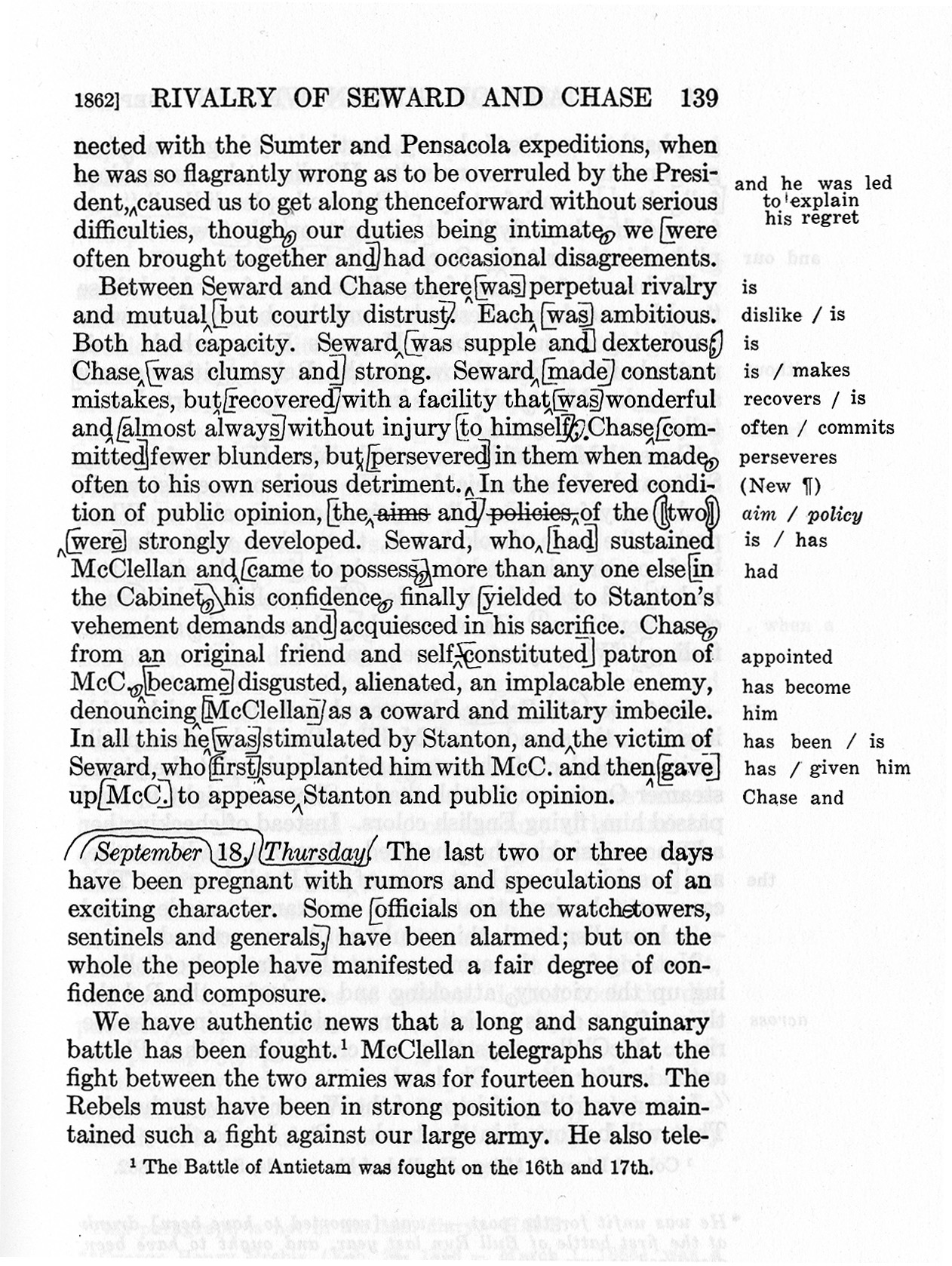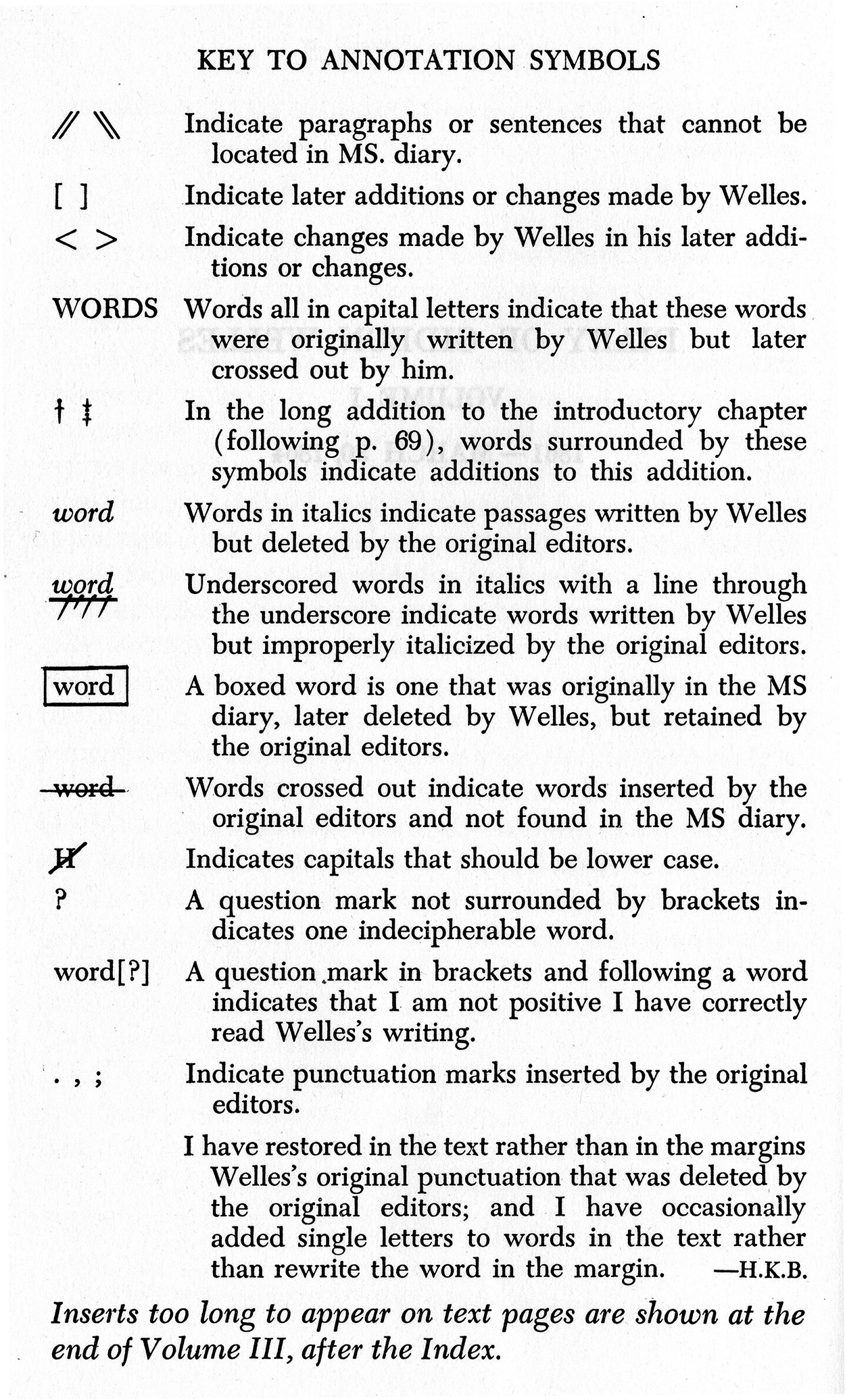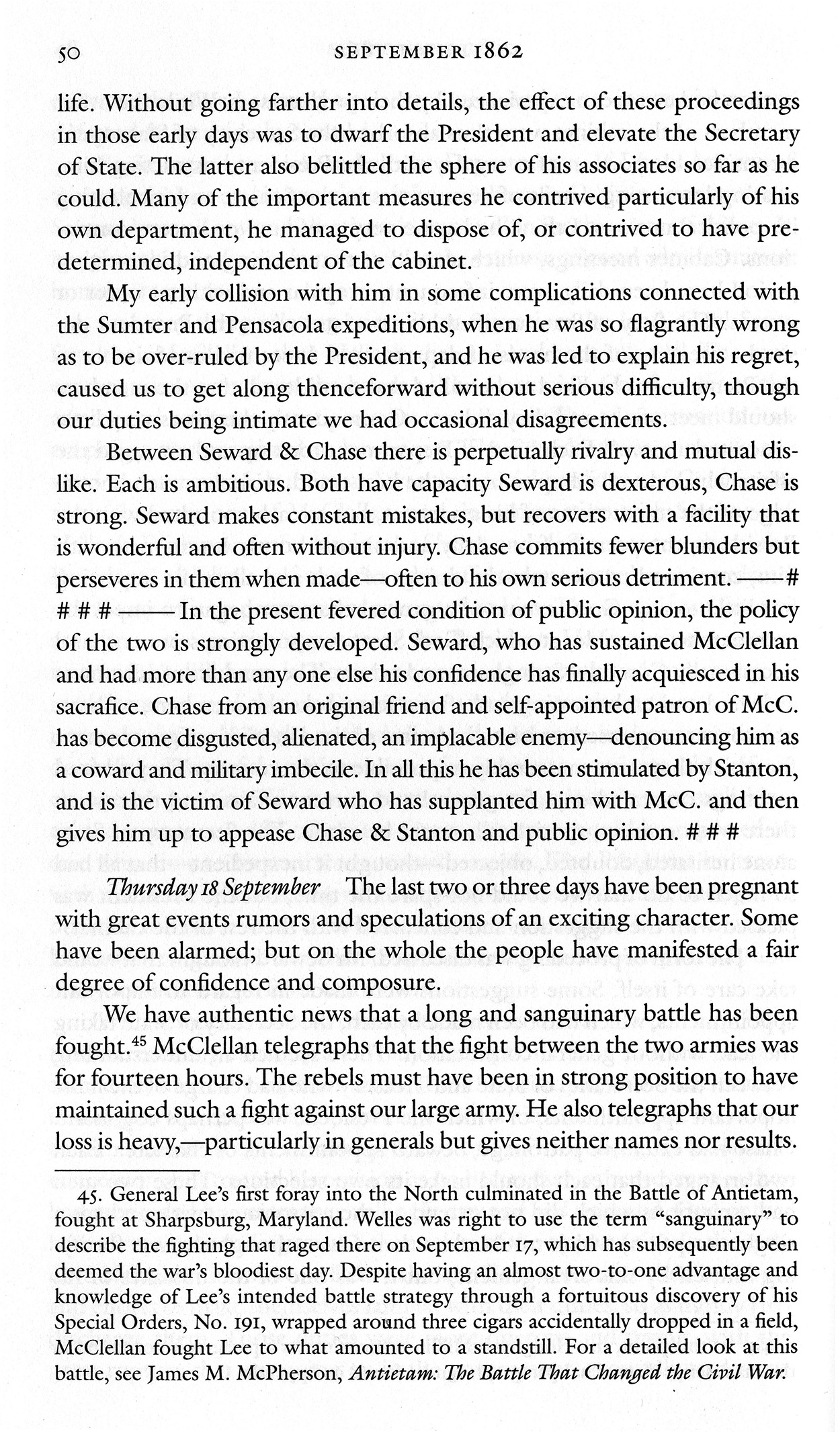Review
Skip other details (including permanent urls, DOI, citation information)
: This work is licensed under a Creative Commons Attribution-NonCommercial-NoDerivatives 3.0 License. Please contact mpub-help@umich.edu to use this work in a way not covered by the license.
For more information, read Michigan Publishing's access and usage policy.
William E. and Erica L. Gienapp, eds. The Civil War Diaries of Gideon Welles, Lincoln’s Secretary of the Navy: The Original Manuscript Edition. Urbana: University of Illinois Press and Knox College Studies Center, 2014. Pp. xxxix, 825.
Historians have long relied on Gideon Welles’s voluminous diaries for a candid, albeit biased, insider’s view of the Abraham Lincoln administration during the trial of the American Civil War and of the Andrew Johnson administration that followed. The diaries were edited and published first in 1911 by Welles’s son Edgar and again in 1960 by long-time University of North Carolina history professor Howard Kennedy Beale. The latter’s edition, as Rodney O. Davis and Douglas L. Wilson, editors of Knox College’s Lincoln Studies series of publications, state in their preface, “has been a mainstay of scholarship on the Civil War ever since” (xiii). This perhaps begs the question of why they have extended their approbation to yet another iteration.
Those familiar with the Welles and Beale editions, especially the former, doubtless will not pose such a question. For those unfamiliar with both, a bit of history is requisite. The elder Welles had kept detailed diaries prior to his appointment as secretary of the navy in March 1861, but the demands of that office evidently prevented him from doing so during the hectic days following the inauguration and the outbreak of war. Indeed, his Civil War diaries proper commence on August 11, 1862, although prior to that date he appears to have kept notes from which he later compiled a retrospective “Narrative of Events Commencing March 6, 1861,” which both Edgar Welles and Beale printed along with the diaries in their editions. Erica Gienapp and the late William Gienapp have consigned this narrative to an appendix in their edition.
The diary entries, made with remarkable diligence until Gideon Welles left office at the end of Johnson’s presidency, were recorded in fifteen leather-bound manuscript volumes now in the Library of Congress. During the remaining nine years of his life, however, Welles “tinkered,” to use the Gienapps’ term, with many of the original entries, “polishing the prose to make it read more smoothly and rewriting sentences to reflect his changing opinions about people and events”(xviii). Edgar Welles, in turn, not only used the revised version as the basis for a typescript but also added his own revisions, spelling “corrections,” and punctuation, as well as excising or amending—sanitizing might be a more apt descriptor—some passages. Moreover, his edition, based on that typescript, contains material of uncertain provenance, neither from the original diary nor from his father’s revisions. In sum, not all of the three-volume 1911 Houghton Mifflin edition was drawn from the diary entries; those portions that were had already been revised by Gideon Welles and then his son; and some of the original text did not appear at all.
The more obvious of these shortcomings were evident to informed contemporaries. In 1910 Yale and later Stanford University history professor Henry Barrett Learned expressed his doubts about the trustworthiness of Edgar Welles’s edition to the Atlantic Monthly, which published excerpts of his typescript that year (xxii). In his American Historical Review notice of the Houghton Mifflin edition, Learned asked whether the elder Welles, following his exit from public life, “revise[d] the original records of this Diary or, at any rate in some instances elaborate[d] them.” Learned then cited two examples in which it appeared Welles had done so, gently concluding with regard to one of them that “it appears to the reviewer to be a passage not likely to have been written under the date given.”[1]
In the early 1920s Harvard professor Edward P. Channing suggested to Howard Beale, then a graduate student working under Channing’s direction, that he undertake a systematic examination of the Edgar Welles edition alongside the manuscript volumes. The result of Beale’s investigation was published in a 1925 American Historical Review article titled “Is the Printed Diary of Gideon Welles Reliable?” The answer was “no.” Indeed, as noted above, the flaws in the 1911 edition eventually prompted Beale, whose research specialization at that time was Reconstruction (for which the diaries are also an invaluable source), to undertake his own edition of the Welles diaries, which appeared a year after his death in 1959.[2]
Problem solved? Alas, not entirely satisfactorily. First of all, rather than starting from scratch by transcribing the original diaries himself, Beale used the 1911 edition as his basis, checking it against the original manuscript to identify revisions, additions, and excisions. He was, in other words, working backward from a defective text, a methodology readily apparent to anyone who has examined his edition. Indeed, it is a facsimile reproduction of the Houghton Mifflin edition, with Beale’s handwritten annotation inserted and, where Gideon or Edgar Welles altered the wording, the text of the original diary inserted in the margin, a method of proceeding so unusual, at least in a published work, that a brief glimpse of it may be necessary in order for those unfamiliar with it to appreciate how curious it appears. The first illustration (fig. 1) comes from the diary entry for September 16, 1862, volume 1, page 139.
Moreover, the annotation system Beale employed might be said to take some getting used to, as the second illustration (fig. 2) shows.
As James McPherson notes in his foreword to the Gienapp edition, while “Beale applied professional standards to his editing process,” his “method of crossed-out words, added marginalia, and mysterious diacritical symbols made this edition extremely user-unfriendly”(xv).
Beale left no clues in the introduction to his edition of the Welles diary as to why he adopted the method of revision that he did. Certainly, as his own work testifies, separating Gideon Welles’s original words from his later emendations is not, for the most part, difficult. Beale states that the original diary entries were inscribed on every other page in the manuscript volumes: the blank pages opposite were used for much of the reworking that took place during the 1870s.[3] Moreover, although Gideon Welles crossed through portions of the original text that were subsequently revised, according to Beale it is rarely difficult to ascertain what he had written.
The Gienapps have reversed Beale’s methodology: rather than working backward from Edgar Welles’s edition, they started from scratch by retranscribing from the manuscript volumes. The difference in appearance is stark. Since Beale’s edition builds on Edgar Welles’s, text amended or later added by either of the Welleses appears in the text, while words or phrases deleted by them appear in the margins. By contrast, the Gienapps’ text consists of the original wording, and the later additions or alterations that they include are consigned to brackets or footnotes. To give a sense of the contrast, the passage from Beale’s edition reproduced above is shown as it appears on page 50 of the Gienapps’ volume (fig. 3).
Moreover, by starting from scratch, the Gienapps vetted the entire manuscript text, whereas Beale restricted his attention to those portions that were revised after their original composition. As a consequence, the former have discovered and corrected transcription errors made by Edgar Welles. Last, but certainly not least, their volume is far more comprehensively annotated than Beale’s, since the latter made no additions to the spartan scholarly apparatus of the younger Welles’s edition.
Has Beale’s edition therefore been wholly superseded by the Gienapps’? No. First of all, his volumes remain essential for those interested in the events of Andrew Johnson’s presidency. Second, Beale’s introduction is equally essential reading for those interested in the history of the diaries, especially Gideon Welles’s own editorial proceedings. Finally, although this point may be of interest to few beyond Welles biographers, Beale’s peculiar methodology has the advantage of enabling researchers to see how Secretary Welles’s views and opinions changed over time. The Gienapps’ edition is certainly more user-friendly, but in it virtually all of Gideon Welles’s later revisions to the original text have been omitted.
Nonetheless, the new edition will be the first choice for most researchers or readers interested in Welles’s account of Lincoln’s administration. Aside from its user-friendliness, it is handsomely produced, sumptuously annotated, well indexed, and, value-priced at forty-five dollars.
Learned review of the Diary of Gideon Welles, American Historical Review 17, no. 3 (April 1912): 631–32.

Howard K. Beale, “Is the Printed Diary of Gideon Welles Reliable?” 30, no. 3 (April 1925): 547–52.

Gideon Welles, Diary of Gideon Welles: Secretary of the Navy under Lincoln and Johnson, edited by Howard K. Beale (New York: W. W. Norton, 1860), 1:xxv.





